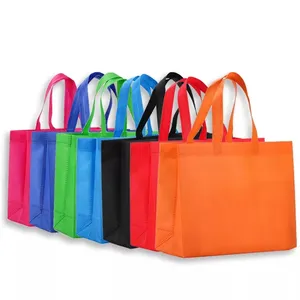Shopping bags are a type of bag commonly used by consumers to carry purchases from a retail store. Most shopping bags are designed to be lightweight, portable, and affordable for single use. They allow customers to conveniently transport multiple purchased items in one trip from the checkout counter to their vehicle or home.
Most shopping bags are made from lightweight, inexpensive materials like paper (kraft paper, recycled paper), plastic (polyethylene, polypropylene), or natural fibers like cotton or jute. Paper and plastic are the most common. Paper shopping bags are biodegradable but less durable when wet. Plastic shopping bags are often the most affordable and durable option for shopping, but they create environmental issues due to their non-biodegradable polyolefin composition. Beyond the basic function of item transport, shopping bags play a role in the consumer experience. Custom logo shopping bags reinforce store branding and may influence future patronage. Free bags are also a perception of store value and service.
Typical grocery shopping bags come in a range of sizes. At the small end are produce bags for fruits and vegetables. Large tote-style bags can hold many pounds of groceries or other goods, allowing consumers to transport heavier loads in a single trip. Handles are also a defining feature of shopping bags across all sizes. They allow the bags to be easily lifted and carried once filled with purchases. With handles, consumers can transport multiple loaded bags conveniently with their hands. Printed logos are commonly featured on shopping bags, particularly the larger sizes. Displaying the retailer's brand serves to promote name recognition both during the shopping experience and after that. As consumers lift and carry bags out of the store, the prominent logos become a moving billboard that can influence future shopping decisions. The branding on bags also reinforces customers' loyalty when they put purchased items away and reuse the durable shopping bags.
Reusable shopping bags are primarily designed to carry items that customers purchase from a retail store. At checkout, customers will load their selections into the provided bags to transport their goods. However, once taken home, shopping bags are often reused for other purposes as well. For example, they may occasionally carry non-store items like packed lunches, sports gear, toys, or other transported items. This repurposing helps maximize the value of shopping bags. For optimal performance, some ideal practices are recommended when using shopping bags: (1) Folding the tops of plastic bags reinforces their structure and strength. This helps prevent tears from occurring as heavy items are placed inside, and the bag is lifted. (2) It is also advisable to separate different types of items, such as raw meats and fresh produce, within the bags to avoid cross-contamination. Keeping these items in their packaging and spaced apart in the bag reduces health risks. (3) Overfilling the bag beyond its intended capacity should also be avoided. It can weaken seams and increase strain on the bag material. This makes tears more likely to happen while items are being transported. Leaving some space at the top maintains bag integrity.








































 浙公网安备 33010002000092号
浙公网安备 33010002000092号 浙B2-20120091-4
浙B2-20120091-4